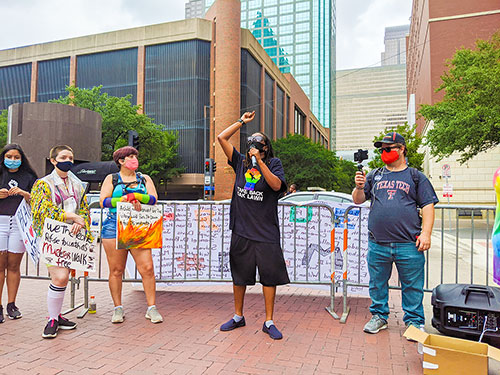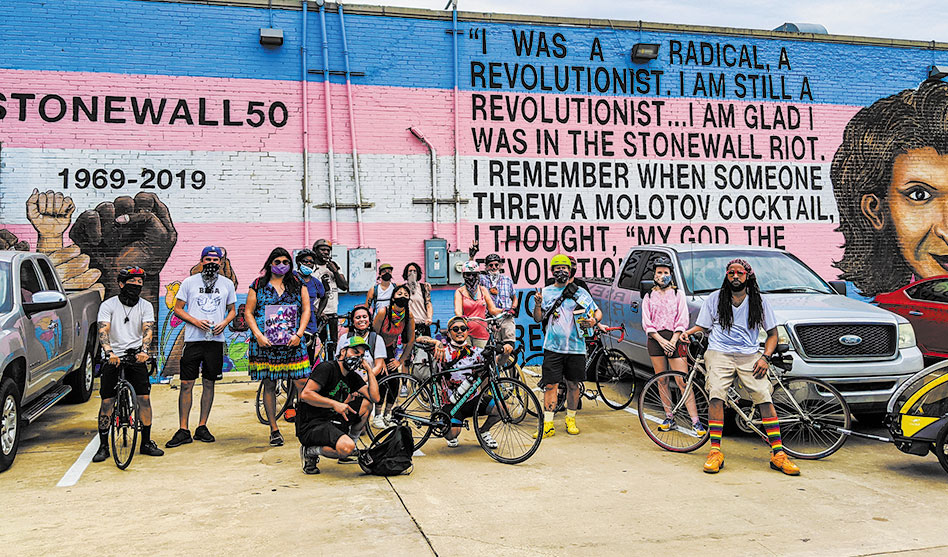The Bicycle Ride for Pride and Black Lives,
Pride for Black Lives Matter march fills streets of Oak Lawn
Steven Monacelli | Contributing Writer
Dallas’ 2020 Pride march on Sunday, June 28, started with about 500 people in Turtle Creek Park and eventually swelled to nearly 1,000 as it wound its way through the Oak Lawn gayborhood. This march was unique for a number of reasons: First, it marked a return to the roots of Pride by rejecting corporate sponsorships, and second, it united previously separated communities for a common cause.
The city’s annual Pride celebration — moved last year from September to June, and from Oak Lawn to Fair Park, and featuring the Miller Lite Music Festival and the Alan Ross Texas Freedom Parade — was initially rescheduled from the first weekend in June to the last weekend in July due to the ongoing COVID-19 pandemic.
In June, organizers announced that, with concerns over the pandemic continuing, the 2020 Pride celebration would be a virtual event rather than an in-person party.
But, in the wake the May 25 murder of George Floyd and with protesters continuing to fill the streets in support of the Black Lives Matter movement, a group of Dallas LGBTQ activists decided to organize the DFW Pride for Black Lives Matter rally and march.
Eric Ramsey, one of the event’s organizers, described the thinking behind the rally: “In previous years, Pride has been more of a party, a celebration. … But it began as a protest directly against police brutality, led by black trans and queer women. We wanted to remind the community what Pride is meant to be. We didn’t just want to dance in the streets to Lady Gaga.”

Activist C.d. Kirven. (Photos by Steven Monacelli)
That was not all. The absence of major corporate sponsors that help pay for and participate in the annual parade was notable at Sunday’s event. In their place came a coterie of community groups ranging from trans activist organizations to the local chapter of the Democratic Socialists of America. Ramsey framed that change as intentional.
“This year, we really wanted Pride to be for the people, by the people,” he said. “Over the years, Pride has become corporatized. Corporations that 11 months of the year don’t really care about the LGBTQIA+ community decide to slap a rainbow on their website and call themselves an ally. But that’s never sat right with me as a gay man.”
This year also saw Black, Latinx and “big” Pride events joining together under the same banner. “Over the years [Dallas Pride] has been more white-centric and party-centric here in Dallas and has left more marginalized communities behind, and we wanted this event to put our black trans and queer brothers and sisters front and center,” Ramsey said.
Reflecting back on Sunday’s march, long-time black LGBTQIA+ activist C.d. Kirven described the rally and march as a “dream come true. … They brought the communities I love so much together and we stood up for each other.
“This event represented a pushback against separation of prides along racial lines, as well as a radical taking back of Pride from the white, corporate-sponsored version that has become dominant,” Kirven said. “It was Pride coming back to its roots as a protest, as a riot.”
This Pride march was certainly a protest. But thankfully — due to skillful de-escalation efforts on behalf of the organizers — it never became a riot, a phenomenon integrally linked to the presence of police violence.
It’s worth remembering that LGBTQ Pride was, indeed, birthed from a riot, one that led by trans and queer women of color Marsha P. Johnson and Silvia Rivera.
This fact was brought home in a powerful way during a Bicycle Ride for Pride and Black Lives, organized by a Dallas-based chef and artist Jordan Edwards and taking place just prior to the rally at the park. The ride concluded at the mural on the side of the building at 4010 Cedar Springs Road. It is one of the largest murals in the world dedicated to trans women, and it focuses on portraits of Johnson and Rivera.
It also features a quote from Rivera: “I was a radical, a revolutionist. I am still a revolutionist. … I am glad I was in the Stonewall riot. I remember when someone threw a Molotov cocktail, I thought, ‘My God, the revolution is here. The revolution is finally here!’”
To be clear, there have been no Molotov cocktails thrown in Dallas. But the atmosphere here over the last month has definitely been radical.
On Sunday morning, Pride, Black Lives Matters and Abolish ICE supporters gathered together to protest Vice President Mike Pence’s visit to First Baptist Dallas. Tensions rose, but coordination across communities and generations allowed for an attitude of joyful militancy to dominate the crowd instead of rage and violence.
Protesters dangled donuts on strings over police barricades and shot off confetti cannons in the direction of the police.
Kirven said the events were necessary. “You have to have these moments of levity in the midst of the struggle. …
If you only focus on the reality of it, you’ll never make it through this whole process.
“It’s not just standing up; it’s a long journey,” she continued. “We have to dance, joke, but also take things seriously.”
This echoes the apocryphal quote attributed to Emma Goldman, an early pioneer of feminist politics, among other things, who said, “If I can’t dance, I don’t want to be in your revolution.”
That joyfully militant atmosphere was redoubled at the march on Sunday evening. The outfits and costumes were festive, ranging from the less-is-more crowd to the Sisters of Perpetual Indulgence who used their habits and wimples to block out the distractions — those distractions mainly being aggressive religious counter-protesters. And the mood was dynamic — joyful, somber and enraged, but always underscored by a strong sense of unity.
Although the Dallas mainstream media’s attention on the ongoing protesters seems to have waned, the protest communities continue to join together, finding common strength. Sunday’s events marked the 31st consecutive day of protest against police brutality in Dallas; those protests continue daily, even now.
Perhaps we should believe the protesters when they chant: “Are you tired? We don’t get tired!”












